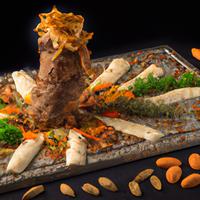
1 serving (100 grams) contains 200 calories, 25.0 grams of protein, 10.0 grams of fat, and 0.0 grams of carbohydrates.

Log this food in SnapCalorie

Nutrition Information
Calories |
476.2 | ||
|---|---|---|---|
% Daily Value* |
|||
| Total Fat | 23.8 g | 30% | |
| Saturated Fat | 10.7 g | 53% | |
| Polyunsaturated Fat | 0 g | ||
| Cholesterol | 190.5 mg | 63% | |
| Sodium | 142.9 mg | 6% | |
| Total Carbohydrates | 0 g | 0% | |
| Dietary Fiber | 0 g | 0% | |
| Sugars | 0 g | ||
| protein | 59.5 g | 119% | |
| Vitamin D | 11.9 mcg | 59% | |
| Calcium | 35.7 mg | 2% | |
| Iron | 5 mg | 27% | |
| Potassium | 785.7 mg | 16% | |
* Percent Daily Values are based on a 2,000 calorie diet. Your daily values may be higher or lower depending on your calorie needs.
Food Attributes
Source of Calories
About Lamb tenderloin
Lamb tenderloin is a lean, flavorful cut of meat prized in various cuisines, including Mediterranean, Middle Eastern, and French culinary traditions. Known for its tender texture and mild yet rich taste, it is often grilled, roasted, or pan-seared to preserve its natural succulence. A great source of high-quality protein, lamb tenderloin is also rich in essential nutrients like iron, zinc, and vitamin B12, which support energy production, immune health, and red blood cell formation. Compared to fattier cuts of lamb, tenderloin is lower in fat, especially saturated fat, making it a healthier choice for those managing their dietary fat intake. However, portion control is key, as lamb is more calorie-dense than some leaner protein options. Pairing lamb tenderloin with nutrient-dense vegetables or whole grains can create a balanced, wholesome meal that is both satisfying and nourishing.



